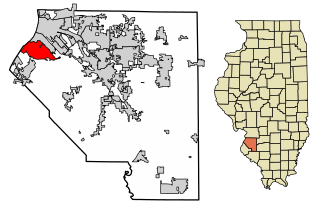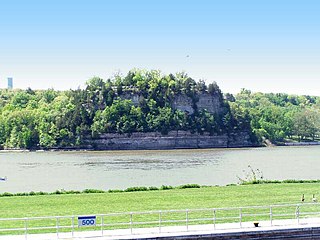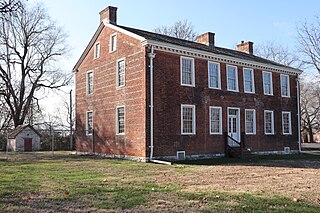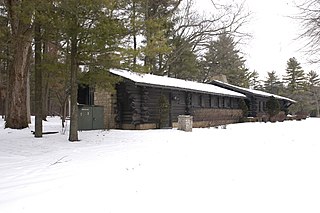Related Research Articles

The National Register of Historic Places (NRHP) is the United States federal government's official list of sites, buildings, structures, districts, and objects deemed worthy of preservation for their historical significance or "great artistic value".

Cahokia is a settlement and former village in St. Clair County, Illinois, United States, founded as a colonial French mission in 1689. Located on the east side of the Mississippi River in the Greater St. Louis metropolitan area, as of the 2010 census, 15,241 people lived in the village. On May 6, 2021, the village was incorporated into the new city of Cahokia Heights.

Starved Rock State Park is a state park in the U.S. state of Illinois, characterized by the many canyons within its 2,630 acres (1,064 ha). Located just southeast of the village of Utica, in Deer Park Township, LaSalle County, Illinois, along the south bank of the Illinois River, the park hosts over two million visitors annually, the most for any Illinois state park.

Lincoln's New Salem State Historic Site is a reconstruction of the former village of New Salem in Menard County, Illinois, where Abraham Lincoln lived from 1831 to 1837. While in his twenties, the future U.S. President made his living in this village as a boatman, soldier in the Black Hawk War, general store owner, postmaster, surveyor, and rail splitter, and was first elected to the Illinois General Assembly.

This is a list of properties and districts in Illinois that are on the National Register of Historic Places. There are over 1,900 in total. Of these, 85 are National Historic Landmarks. There are listings in all of the state's 102 counties.
This National Park Service list is complete through NPS recent listings posted January 24, 2025.

The Old State Capitol State Historic Site, in Springfield, Illinois, is a former capitol building for the U.S. state of Illinois, and one of two preserved former Illinois capitol buildings. It was built in the Greek Revival style in 1837–1840, when Springfield became the capital city, and served as the state house from 1840 to 1876, when it was replaced by the current capitol. It is the site of candidacy announcements by Abraham Lincoln in 1858 and Barack Obama in 2007. It was designated a National Historic Landmark in 1961, primarily for its association with Lincoln and his political rival Stephen Douglas.

The Vandalia State House, built in 1836, is the fourth capitol building of the U.S. state of Illinois. It is also the oldest capitol building in Illinois to survive, as the first, second, and third capitol buildings have all disappeared. The brick Federal style state house has been operated by the state of Illinois as a monument of Illinois' pioneer years since 1933. It is located in Vandalia, Illinois, on the National Road, and listed on the National Register of Historic Places.

The Cahokia Courthouse State Historic Site is a reconstructed French-Canadian structure built about 1740 at what is now 107 Elm Street, Cahokia Heights, Illinois. At various times it has served as a house and as a courthouse. It is currently interpreted to resemble its appearance about 1800 as a frontier courthouse of the Northwest Territory. The courthouse was listed on the National Register of Historic Places on November 9, 1972.

The Nicholas Jarrot Mansion is a historic house at 124 East First Street in Cahokia Heights, Illinois and is operated as an inactive historic site by the Illinois Historic Preservation Agency (IHPA). It is a State Historic Site, is listed on the National Register of Historic Places, and became a National Historic Landmark in 2001. Built in 1807–1810 for the son of French colonists, it is an extremely rare example of Federal architecture in the upper Mississippi River valley.

The White Pines State Park Lodge and Cabins are located in rural Ogle County, Illinois near the village of Mount Morris. They were added to the National Register of Historic Places in 1985. The Cabins are one of two Historic Places found in or near Mount Morris, the other is the Samuel M. Hitt House. The Lodge and Cabins are part of a National Register Multiple Property Submission, they were submitted with several other state park lodges, all designed by Joseph F. Booton.

Illinois State Park Lodges and Cabins Thematic Resources is a Multiple Property Submission on the National Register of Historic Places in the U.S. state of Illinois. The listing includes the lodge and cabin sites in five different Illinois State Parks.

Lowden State Park is an Illinois state park on 207 acres (84 ha) in Ogle County, Illinois, United States. It is named for Governor Frank Orren Lowden, who served from 1917 to 1921, and is home to The Eternal Indian, a statue by Lorado Taft. Along with eleven other parks, it was briefly closed after budget cuts in 2008.

Apple River Fort, today known as the Apple River Fort State Historic Site, was one of many frontier forts hastily completed by settlers in northern Illinois and southern Wisconsin following the onset of the 1832 Black Hawk War. Located in present-day Elizabeth, Illinois, United States, the fort at the Apple River settlement was built in less than a week. It was one of the few forts attacked during the war and the only one attacked by a band led by Black Hawk himself. At the Battle of Apple River Fort, a firefight of about an hour ensued, with Black Hawk's forces eventually withdrawing. The fort suffered one militia man killed in action, and another wounded. After the war, the fort stood until 1847, being occupied by squatters before being sold to a private property owner who dismantled the building.

Washington Park Historic District, also known as Washington Square is a historic district in and around Washington Park in the city of Ottawa, Illinois, United States. Washington Park was the site of the first Lincoln-Douglas debates of 1858 and is surrounded by several historic structures. The park was platted in 1831 and the historic district was added to the United States National Register of Historic Places in 1973.
A Mississippi Landmark is a building officially nominated by the Mississippi Department of Archives and History and approved by each county's chancery clerk. The Mississippi Landmark designation is the highest form of recognition bestowed on properties by the state of Mississippi, and designated properties are protected from changes that may alter the property's historic character. Currently there are 890 designated landmarks in the state. Mississippi Landmarks are spread out between eighty-one of Mississippi's eighty-two counties; only Issaquena County has no such landmarks.
The Abraham Lincoln National Heritage Area is a National Heritage Area in central Illinois telling the story of Abraham Lincoln. Spanning 43 counties, it is a federally-designated area intended to encourage historic preservation and an appreciation of the history and heritage of the site, with assistance from the National Park Service.

The Emerald Mound and Village Site is a pre-Columbian archaeological site located northwest of the junction of Emerald Mound Grange and Midgley Neiss Roads in St. Clair County, Illinois. The site includes five mounds, two of which have been destroyed by modern activity, and the remains of a village. Middle Mississippian peoples inhabited the village, which was a satellite village of Cahokia. The largest of the mounds is a two-tiered structure that stands 50 feet (15 m) high; its square base is 300 feet (91 m) across, while its upper tier is 150 feet (46 m) across. At the time of its discovery, the mound was the second-largest known in Illinois after Monks Mound at Cahokia.

The Power Farmstead is a historic farm located on County Road 9500N east of Cantrall, Illinois. George Power, a prominent early settler of northern Sangamon County, established the farm in the 1820s. The farm includes an intact collection of buildings which represent typical 19th-century farm life. In addition, the original farmhouse served as a local courthouse, as Power was Sangamon County's justice of the peace for two decades; Abraham Lincoln argued his first case in the courthouse. The farm was added to the National Register of Historic Places on May 1, 1989.

The St. Clair County Courthouse is a government building in Belleville, the county seat of St. Clair County, Illinois, United States. Built in 1976, it is the fifth courthouse in the history of the county, and one of two that still stands.
References
- ↑ "Illinois Historic Preservation Agency fights for survival". Chicago Tribune. April 16, 2015. Retrieved May 8, 2015.
- ↑ "Illinois' Lincoln Presidential Library Made Separate Agency". www.peoriapublicradio.org. 31 March 2017. Retrieved 2019-01-11.
- ↑ "Illinois Historic sites". Illinois Historic Preservation Division. Retrieved 2018-04-21.
- ↑ "Governor Small Memorial and Park". Illinois Historic Preservation Office. Retrieved 17 January 2019.
- ↑ "Purple Heart Memorial". Illinois Historic Preservation Office. Retrieved 17 January 2019.
- ↑ "Korean War Memorial". Illinois Historic Preservation Office. Retrieved 17 January 2019.